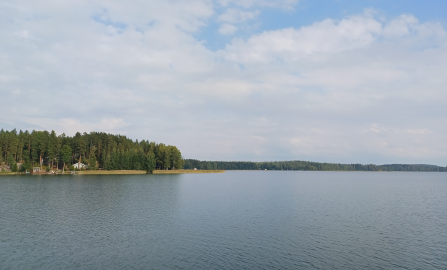Lake Vesijärvi, Finland
Successful restoration of a lake affected by nutrients from industrialisation, sewage and agriculture.
Site description
Lake Vesijärvi in southern Finland is a large lake system (107 km2) consisting of five sub-basins. The seepage lake is located in between the Salpausselkä ridges where it was formed after the Ice Age. Vesijärvi is surrounded by the City of Lahti and the two municipalities of Asikkala and Hollola. Catchment’s land use is dominated by forestry (51%), agriculture (18%) and built environment (8%). Some of the lake’s bay areas belong to Natura 2000 due to their importance for waterfowl.
The lake previously suffered from severe external loading originating from industrialisation and urban growth. These led to accelerating eutrophication with extensive blooms of cyanobacteria in the 1960s and ever since. A pioneering lake restoration project “Lake Vesijärvi -project” (1987) and its sequels have introduced several restoration efforts to reduce symptoms of eutrophication and to secure the recreational value of the lake. A dedicated Vesijärvi Foundation for the protection and restoration of the lake was established in 2007.
Restoration measures applied
Narrative including measures applied and success or failure to improve.
Slow recovery of Lake Vesijärvi from eutrophication began in the mid-1970s after the establishment of a new water treatment plant and diversion of sewage inputs. Since 1989, continuous biomanipulation has significantly reduced the cyanobacterial blooms. Various water protection structures such as buffer zones, two-stage channels, bottom dam series, or wetlands and sedimentation ponds have been introduced across the catchment to limit the diffuse inputs of nutrients. Actions have succeeded to improve the ecological status of the largest basin to good. However, the other basins continue to suffer from high past loading and remain in moderate ecological status.
Current goals of restoration at the site
To reduce external and internal loading further and achieve the WFD target of Good Ecological Status in each of the lake basins. Additionally, to support adapting to climate change-induced changes in temperature, precipitation, and runoff. Ultimately restoration measures aim to secure good habitat condition for freshwater-dependent species and to restore water quality in the lake to ensure recreation.
Sectors and stakeholders involved in lake basin management
Stakeholders include agriculture, forestry (timber) and fisheries sectors. Additionally, various companies and businesses are involved in financing the lake management activities. The lake also has a significant recreational value (fishing, boating, bathing).
Further reading
https://www.vesijarvi.fi/en/lake-vesijarvi/
EEA Europe's state of water 2024: the need for improved water resilience. https://www.eea.europa.eu/en/analysis/publications/europes-state-of-water-2024
Salonen, K., Sarvala, J., Horppila, J. et al. 2020. Development of Lake Vesijärvi through four decades of remediation efforts. Hydrobiologia 847, 4601–4619. https://doi.org/10.1007/s10750-020-04338-3
Jilbert, T., Jokinen, S., Saarinen, T. et al. 2020. Impacts of a deep reactive layer on sedimentary phosphorus dynamics in a boreal lake recovering from eutrophication. Hydrobiologia 847, 4401–4423. https://doi.org/10.1007/s10750-020-04289-9
Anttila, S., Ketola, M., Kuoppamäki, K., Kairesalo, T. 2013. Identification of a biomanipulation-driven regime shift in Lake Vesijärvi: implications for lake management. Freshwater Biology 58, 1494–1502. https://doi.org/10.1111/fwb.12150
